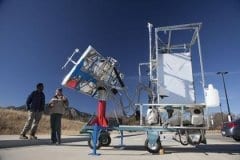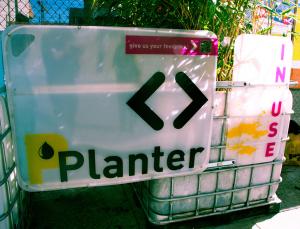
A revolutionary University of Colorado Boulder toilet fueled by the sun that is being developed to help some of the 2.5 billion people around the world lacking safe and sustainable sanitation will be unveiled in India this month.
The self-contained, waterless toilet, designed and built using a $777,000 grant from the Bill & Melinda Gates Foundation, has the capability of heating human waste to a high enough temperature to sterilize human waste and create biochar, a highly porous charcoal, said project principal investigator Karl Linden, professor of environmental engineering. The biochar has a one-two punch in that it can be used to both increase crop yields and sequester carbon dioxide, a greenhouse gas.
The project is part of the Gates Foundation’s “Reinvent the Toilet Challenge,” an effort to develop a next-generation toilet that can be used to disinfect liquid and solid waste while generating useful end products, both in developing and developed nations, said Linden. Since the 2012 grant, Linden and his CU-Boulder team have received an additional $1 million from the Gates Foundation for the project, which includes a team of more than a dozen faculty, research professionals and students, many working full time on the effort.
According to the Gates Foundation, the awards recognize researchers who are developing ways to manage human waste that will help improve the health and lives of people around the world. Unsafe methods to capture and treat human waste result in serious health problems and death – food and water tainted with pathogens from fecal matter results in the deaths of roughly 700,000 children each year.
Linden’s team is one of 16 around the world funded by the Gates “Reinvent the Toilet Challenge” since 2011. All have shipped their inventions to Delhi, where they will be on display March 22 for scientists, engineers and dignitaries. Other institutional winners of the grants range from Caltech to Delft University of Technology in the Netherlands and the National University of Singapore.
The CU-Boulder invention consists of eight parabolic mirrors that focus concentrated sunlight to a spot no larger than a postage stamp on a quartz-glass rod connected to eight bundles of fiber-optic cables, each consisting of thousands of intertwined, fused fibers, said Linden. The energy generated by the sun and transferred to the fiber-optic cable system — similar in some ways to a data transmission line — can heat up the reaction chamber to over 600 degrees Fahrenheit to treat the waste material, disinfect pathogens in both feces and urine, and produce char.
“Biochar is a valuable material,” said Linden. “It has good water holding capacity and it can be used in agricultural areas to hold in nutrients and bring more stability to the soils.” A soil mixture containing 10 percent biochar can hold up to 50 percent more water and increase the availability of plant nutrients, he said. Additionally, the biochar can be burned as charcoal and provides energy comparable to that of commercial charcoal.
Linden is working closely with project co-investigators Professor R. Scott Summers of environmental engineering and Professor Alan Weimer chemical and biological engineering and a team of postdoctoral fellows, professionals, graduate students, undergraduates and a high school student.
“We are doing something that has never been done before,” said Linden. “While the idea of concentrating solar energy is not new, transmitting it flexibly to a customizable location via fiber-optic cables is the really unique aspect of this project.” The interdisciplinary project requires chemical engineers for heat transfer and solar energy work, environmental engineers for waste treatment and stabilization, mechanical engineers to build actuators and moving parts and electrical engineers to design control systems, Linden said.
Tests have shown that each of the eight fiber-optic cables can produce between 80 and 90 watts of energy, meaning the whole system can deliver up to 700 watts of energy into the reaction chamber, said Linden. In late December, tests at CU-Boulder showed the solar energy directed into the reaction chamber could easily boil water and effectively carbonize solid waste.
While the current toilet has been created to serve four to six people a day, a larger facility that could serve several households simultaneously is under design with the target of meeting a cost level of five cents a day per user set by the Gates Foundation. “We are continuously looking for ways to improve efficiency and lower costs,” he said.
The Latest on: Solar-powered toilet
[google_news title=”” keyword=”Solar-powered toilet” num_posts=”10″ blurb_length=”0″ show_thumb=”left”]
via Google News
The Latest on: Solar-powered toilet
- Highlights From Milan Design Week 2024on April 27, 2024 at 11:06 am
At Fuorisalone during Milan Design Week designers and exhibitors explored themes around high and low tech, environmental care, and a touch of magic.
- Solar lights mean shack dwellers can walk to the toilet at nighton April 27, 2024 at 8:59 am
Resident Ntombi Soya said she could finally walk to the toilet at night safely. ‘Lighting has been one of the biggest issues here,’ she said. The City of Cape Town says it is also looking into ...
- Deluxe Sprinter Camper Van Boasts an Incinerating Toilet and Many Other High-End Featureson April 26, 2024 at 1:40 pm
Climb on the roof via a ladder on the passenger side, and you'll discover an Aluminess roof rack holding a 320 W solar panel ... for a propane-powered one in this build, also known as the Cinderella ...
- Woodland Group unveils its largest solar projecton April 23, 2024 at 7:41 am
Woodland Group has announced its largest solar installation to date, set to contribute 60% of its Doncaster site’s electricity demand.
- Left over PV panels and battery storage help solar farm builders dump dieselon April 18, 2024 at 10:40 pm
How do you power a solar farm construction site? Usually with diesel generators. A Victorian project has opted for battery storage and left over PV panels.
- Score a Sam's Club annual membership for just $14 — that's over 70% off and the lowest price we've ever seenon April 17, 2024 at 1:16 pm
As a Sam's Club member, you can stock up on all your household essentials — toilet paper, coffee, dog food, cereal — at wholesale prices. You'll also find exclusive discounts on big-ticket items ...
- Can you use the toilet during the eclipse? Answering the wildest questions about eclipseson April 6, 2024 at 10:01 pm
The total solar eclipse will take the spotlight Monday, April 8, 2024. The rarity and mystique surrounding this event has led to a plethora of questions and speculations. As eclipse anticipation ...
- Barlow’s Park in Tadley to become solar powered thanks to £40k grant from Basingstoke and Deane Borough Councilon April 5, 2024 at 5:51 am
The £40,000 grant will allow the association to install solar panels on the Stacey Pavilion. Silchester Village Hall also benefitted from the fund, receiving £30,000 to complete a toilet ...
- Cromer Cadogan Road toilets to close to install solar panelson October 1, 2023 at 4:30 am
and the Runton Road Car Park It comes as the council recently announced that a new solar-powered toilet block and Changing Places disabled access changing facility is opening in North Walsham's ...
- Nearly a Billion People Still Defecate Outdoors. Here’s Why.on December 18, 2022 at 5:04 am
Waterless, solar-powered toilets that are under development ... away one that’s full of waste from a family’s composting toilet. He’ll deliver the solid waste to a site in the nearby town ...
via Bing News










